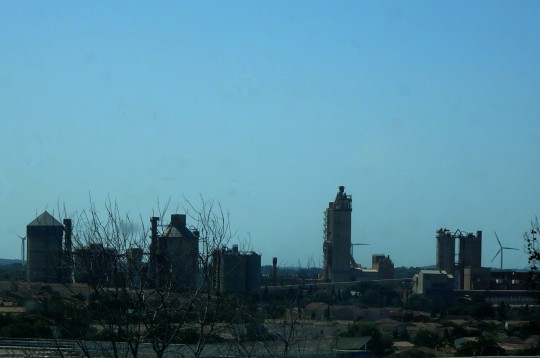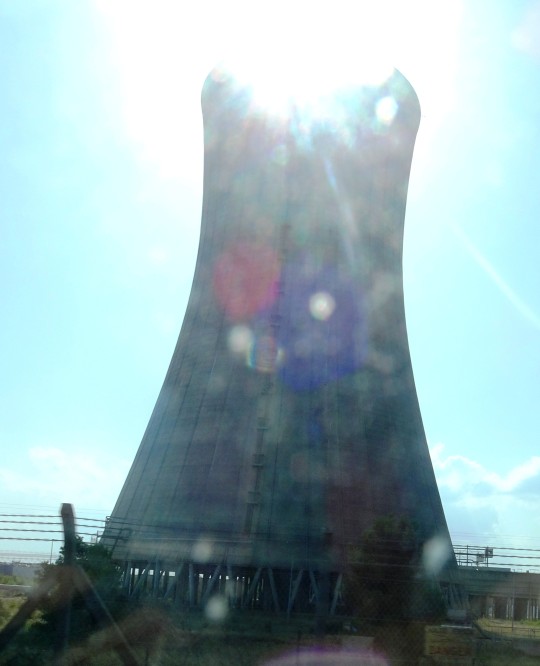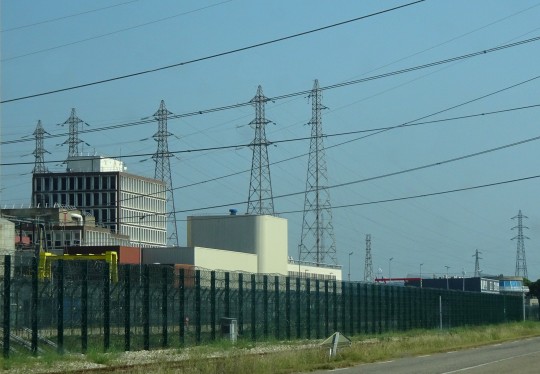#Pierrelatte
Text

Pierrelatte, le Rond-Point.
28 notes
·
View notes
Text






La semaine dernière, j'ai retrouvé mes amis Julien et Katie à Remoulins dans le Gard (Languedoc).
Ici, on est entre trois régions, Ardèche, Provence et Languedoc...
Bon allons au pire, tellement moche que ça en devient "beau" !
les 2 premières : Beaucaire avec une cimenterie (?) aux allures de Carcassonne post-apocalyptique !
les 3 suivantes : Pierrelatte
la dernière : le barrage de Vallabrègues, non loin de Beaucaire, sur une dérivation du Rhône
#provence#languedoc#beaucaire#architecture#usine#pierrelatte#pylône#centrale thermique#cimenterie#vallabrègues#barrage#barrage de vallabrègues#rhône
3 notes
·
View notes
Video
F-AZAH / 254 - Morane Saulnier MS 315 by Laurent Quérité
Via Flickr:
Meeting Aérien Airshow Aérodrome du Tricastin Pierrelatte (LFHD) Drôme France IMG_2970
#Canon EF 100-400mm f/4.5-5.6L IS USM#CanonFrance#Canon EOS 7D#Canonphotography#Aviation#Aéronef#Avion#Avgeeks#Aviationlovers#Aviationphotography#Meeting Aérien#Airshow#Aérodrome du Tricastin#LFHD#Pierrelatte#Drôme#France#F-AZAH#Morane Saulnier#MS 315#Laurent Quérité#flickr
15 notes
·
View notes
Text
Jour 5 - De Montélimar à Pont-Saint-Esprit
Le départ de l’hôtel fut tranquille, sous un ciel bleu étincelant et un mistral dynamique.
Notre trajet en vélo s’est passé sans entrave.Bien qu’il y ait eu un panneau « Chemin inondé » avant Bourg-Saint-Andéol, nous avons passer sans problèmes.
La ViaRhôna était très agréable.Nous avons bien zigzagué dans la plaine de Pierrelatte.
Notre arrivée sur Pont-St-Esprit fut rapide.Nous avons nous…

View On WordPress
0 notes
Text
Blague : La ferme aux crocodiles de Pierrelatte......RHOOOOOOOOOOO........
Continue reading Untitled

View On WordPress
0 notes
Text
1 note
·
View note
Video
Film réalisé par les élèves du Lycée Gustave Jaume à Pierrelatte dans la Drôme intitulé Témoignages. Résultat d’un atelier mené avec l’association De l’Ecrit à l’Ecran.
0 notes
Note
Natural nuclear fission reactor
A natural nuclear fission reactor is a uranium deposit where self-sustaining nuclear chain reactions occur. The conditions under which a natural nuclear reactor could exist had been predicted in 1956 by Japanese American chemist Paul Kuroda.[1] The remnants of an extinct or fossil nuclear fission reactor, where self-sustaining nuclear reactions have occurred in the past, can be verified by analysis of isotope ratios of uranium and of the fission products (and the stable daughter nuclides of those fission products). An example of this phenomenon was discovered in 1972 in Oklo, Gabon by French physicist Francis Perrin under conditions very similar to Kuroda's predictions.
Oklo is the only location where this phenomenon is known to have occurred, and consists of 16 sites with patches of centimeter-sized ore layers. Here self-sustaining nuclear fission reactions are thought to have taken place approximately 1.7 billion years ago, during the Statherian period of the Paleoproterozoic, and continued for a few hundred thousand years, probably averaging less than 100 kW of thermal power during that time.[2][3][4]
History
In May 1972 at the Tricastin uranium enrichment site at Pierrelatte in France, routine mass spectrometry comparing UF6 samples from the Oklo Mine, located in Gabon, showed a discrepancy in the amount of the U-235
isotope. Normally the concentration is 0.72% while these samples had only 0.60%, a significant difference (some 17% less U-235 was contained in the samples than expected).[5] This discrepancy required explanation, as all civilian uranium handling facilities must meticulously account for all fissionable isotopes to ensure that none are diverted to the construction of nuclear weapons. Furthermore since fissile material is why people mine uranium, a significant amount "going missing" was also of direct economic concern.
Thus the French Commissariat à l'énergie atomique (CEA) began an investigation. A series of measurements of the relative abundances of the two most significant isotopes of the uranium mined at Oklo showed anomalous results compared to those obtained for uranium from other mines. Further investigations into this uranium deposit discovered uranium ore with a U-235 concentration as low as 0.44% (almost 40% below the normal value). Subsequent examination of isotopes of fission products such as neodymium and ruthenium also showed anomalies, as described in more detail below. However, the trace radioisotope U-234 did not deviate significantly in its concentration from other natural samples. Both depleted uranium and reprocessed uranium will usually have U-234 concentrations significantly different from the secular equilibrium of 55 ppm U-234 relative to U-238. This is due to U-234 being enriched together with U-235 and due to it being both consumed by neutron capture and produced from U-235 by fast neutron induced (n,2n) reactions in nuclear reactors. In Oklo any possible deviation of U-234 concentration present at the time the reactor was active would have long since decayed away. U-236 must have also been present in higher than usual ratios during the time the reactor was operating, but due to its half life of 2.348×107 years being almost two orders of magnitude shorter than the time elapsed since the reactor operated, it has decayed to roughly 1.4×10−22 its original value and thus basically nothing and below any abilities of current equipment to detect.
This loss in U-235 is exactly what happens in a nuclear reactor. A possible explanation was that the uranium ore had operated as a natural fission reactor in the distant geological past. Other observations led to the same conclusion, and on 25 September 1972 the CEA announced their finding that self-sustaining nuclear chain reactions had occurred on Earth about 2 billion years ago. Later, other natural nuclear fission reactors were discovered in the region.
Mechanism
The natural nuclear reactor formed when a uranium-rich mineral deposit became inundated with groundwater, which could act as a moderator for the neutrons produced by nuclear fission. A chain reaction took place, producing heat that caused the groundwater to boil away; without a moderator that could slow the neutrons, however, the reaction slowed or stopped. The reactor thus had a negative void coefficient of reactivity, something employed as a safety mechanism in human-made light water reactors. After cooling of the mineral deposit, the water returned, and the reaction restarted, completing a full cycle every 3 hours. The fission reaction cycles continued for hundreds of thousands of years and ended when the ever-decreasing fissile materials, coupled with the build-up of neutron poisons, no longer could sustain a chain reaction.
Fission of uranium normally produces five known isotopes of the fission-product gas xenon; all five have been found trapped in the remnants of the natural reactor, in varying concentrations. The concentrations of xenon isotopes, found trapped in mineral formations 2 billion years later, make it possible to calculate the specific time intervals of reactor operation: approximately 30 minutes of criticality followed by 2 hours and 30 minutes of cooling down (exponentially decreasing residual decay heat) to complete a 3-hour cycle.[6] Xenon-135 is the strongest known neutron poison. However, it is not produced directly in appreciable amounts but rather as a decay product of Iodine-135 (or one of its parent nuclides). Xenon-135 itself is unstable and decays to Caesium-135 if not allowed to absorb neutrons. While Caesium-135 is relatively long lived, all Caesium-135 produced by the Oklo reactor has since decayed further to stable Barium-135. Meanwhile Xenon-136, the product of neutron capture in Xenon-135 only decays extremely slowly via double beta decay and thus scientists were able to determine the neutronics of this reactor by calculations based on those isotope ratios almost two billion years after it stopped fissioning uranium.
A key factor that made the reaction possible was that, at the time the reactor went critical 1.7 billion years ago, the fissile isotope U-235 made up about 3.1% of the natural uranium, which is comparable to the amount used in some of today's reactors. (The remaining 96.9% was non-fissile U-238 and roughly 55 ppm U-234.) Because U-25 has a shorter half-life than U-238, and thus decays more rapidly, the current abundance of U-235 in natural uranium is only 0.72%. A natural nuclear reactor is therefore no longer possible on Earth without heavy water or graphite.[7]
The Oklo uranium ore deposits are the only known sites in which natural nuclear reactors existed. Other rich uranium ore bodies would also have had sufficient uranium to support nuclear reactions at that time, but the combination of uranium, water and physical conditions needed to support the chain reaction was unique, as far as is currently known, to the Oklo ore bodies. It is also possible, that other natural nuclear fission reactors were once operating but have since been geologically disturbed so much as to be unrecognizable, possibly even "diluting" the uranium so far that the isotope ratio would no longer serve as a "fingerprint". Only a small part of the continental crust and no part of the oceanic crust reaches the age of the deposits at Oklo or an age during which isotope ratios of natural uranium would have allowed a self sustaining chain reaction with water as a moderator.
Another factor which probably contributed to the start of the Oklo natural nuclear reactor at 2 billion years, rather than earlier, was the increasing oxygen content in the Earth's atmosphere.[4] Uranium is naturally present in the rocks of the earth, and the abundance of fissile U-235 was at least 3% or higher at all times prior to reactor startup. Uranium is soluble in water only in the presence of oxygen.[citation needed] Therefore, increasing oxygen levels during the aging of the Earth may have allowed uranium to be dissolved and transported with groundwater to places where a high enough concentration could accumulate to form rich uranium ore bodies. Without the new aerobic environment available on Earth at the time, these concentrations probably could not have taken place.
It is estimated that nuclear reactions in the uranium in centimeter- to meter-sized veins consumed about five tons of U-235 and elevated temperatures to a few hundred degrees Celsius.[4][8] Most of the non-volatile fission products and actinides have only moved centimeters in the veins during the last 2 billion years.[4] Studies have suggested this as a useful natural analogue for nuclear waste disposal.[9] The overall mass defect from the fission of five tons of U-235 is about 4.6 kilograms (10 lb). Over its lifetime the reactor produced roughly 100 megatonnes of TNT (420 PJ) in thermal energy, including neutrinos. If one ignores fission of plutonium (which makes up roughly a third of fission events over the course of normal burnup in modern humanmade light water reactors), then fission product yields amount to roughly 129 kilograms (284 lb) of Technetium-99 (since decayed to Ruthenium-99) 108 kilograms (238 lb) of Zirconium-93 (since decayed to Niobium-93), 198 kilograms (437 lb) of Caesium-135 (since decayed to Barium-135, but the real value is probably lower as its parent nuclide, Xenon-135, is a strong neutron poison and will have absorbed neutrons before decaying to Cs-135 in some cases), 28 kilograms (62 lb) of Palladium-107 (since decayed to Silver), 86 kilograms (190 lb) of Strontium-90 (long since decayed to Zirconium) and 185 kilograms (408 lb) of Caesium-137 (long since decayed to Barium).
Relation to the atomic fine-structure constant
The natural reactor of Oklo has been used to check if the atomic fine-structure constant α might have changed over the past 2 billion years. That is because α influences the rate of various nuclear reactions. For example, Sm-149 captures a neutron to become Sm-150, and since the rate of neutron capture depends on the value of α, the ratio of the two samarium isotopes in samples from Oklo can be used to calculate the value of α from 2 billion years ago.
Several studies have analysed the relative concentrations of radioactive isotopes left behind at Oklo, and most have concluded that nuclear reactions then were much the same as they are today, which implies α was the same too.[10][11][12]
Yk what I asked for unhinged - can I really complain about. Whatever this is?
Anyway thanks anon for finally pushing me to add "long post" to my filtered tags because god knows I refuse to read anything this long and educational
#it had to be science#i find most nerdy shit interesting but GOD#science???#makes my eyes glaze over i hate it#anyway thanks anon <3<#me.txt#ask#answer#anon#long post
1 note
·
View note
Photo

@waveislandofficiel L'équipe WAVE ISLAND vous retrouve aujourd'hui au salon CSE de La Ferme aux Crocodiles à Pierrelatte ! Venez profiter des avantages comités d'entreprise et assimilés. Offre spéciale billetterie aujourd'hui sur le salon ! N'hésitez pas à venir nous voir 😉 @lafermeauxcrocos (à Monteux) https://www.instagram.com/p/CoKdyZ7o_cc/?igshid=NGJjMDIxMWI=
0 notes
Link
0 notes
Photo

Je vais regarder l'émission en replay cette après-midi. J'arrivais pas hier soir. J'avais quasiment le même âge que Grégory il était de 1983 je suis de 1985. Je me suis tout de suite attachée à ce jeune à la voix trop exceptionnel et au courage immense immense. J'adore la musique (c'est mon papa qui m'a bcp transmis le virus), j'adore chanter, danser, je joue un peu de guitare et de piano, j'adore les concerts, les bœufs musicaux, les petits concerts et les festivals de musique. Grégory Lemarchal il a marqué ma vie au fer rouge je pense très souvent à lui. Je voulais absolument absolument le voir sur scène c'était en 2006. C'est le candidat qui m'a le plus marqué de toutes les émissions de chant partout dans le monde avec Adam Lambert (qui a fini 2ème d'American Idol en 2009), Susan Boyle, Julien Doré, Nolwenn Leroy, L5 (parce que ma plus vieille amie d'enfance Mélissa est la cousine de Marjorie Parascandola l'une des L5 qui est de Pierrelatte je l'ai oublié elle parmi les Pierrelattins célèbres), Kendji Girac (que j'ai vu dans les Arènes de Nîmes avec Bastien c'était un moment dingue), One Direction et les Little Mix (je les ai vu au Zénith de Paris les Little Mix, c'était un moment très spécial ce concert j'avais vu ça des milliers de Jeunes bcp de filles qui sortent du concert en chantant dans les allées de la Halle de la Villette jusqu'au 1er métro) https://www.instagram.com/p/Ck5dUxpr4Ps/?igshid=NGJjMDIxMWI=
0 notes
Text
Origami animaux pdf
ORIGAMI ANIMAUX PDF >> DOWNLOAD LINK
vk.cc/c7jKeU
ORIGAMI ANIMAUX PDF >> READ ONLINE
bit.do/fSmfG
origami facile lapin
origami facile pdf
origami oiseau pdforigami cycle 3 pdf
origami à imprimer gratuit
origami facile et rapide animaux
origami pdf gratuit
origami facile a4
DE SAFARI ORIGAMI. Il y a plus de vingt ans, je commençais une série de pliages sur le thème des animaux africains. Sans le savoir, je venais. [PDF] Origamis animaux. « Origami » vient de deux mots japonais qui signifient « plier » et « papier ». Par ce joli mot on désigne l'art du pliage. 2. Histoire de l'origami L'Origami devient un art japonais du papier plié. colorés, des masques, des fleurs, des animaux, des accessoires,etc. « Origami » vient de deux mots japonais qui signifient « plier » et « papier ». Par ce joli mot, on désigne l'art du pliage. 2. Page 9 [PDF] Tuto gratuit: origami renard à télécharger -. Et si nous faisions un origami à message avec les enfants? C'est facile, Diagrammes origami format pdf facile et gratuit découvrez des modèles à refaire cher soi ou avec le logiciel Origami chien facile png maron vectoriel Origami - pliage des animaux. A partir d'une simple feuille de papier carré, et simplement en effectuant 2 ou 3 plis, tu réaliseras.Activité vacances - Origami Facile - Ville de Pierrelatte. Voici un tutoriel d'un origami facile : Le chien.. Pour cela il vous faudra un carré en papier coloré Origami - pliage des animaux A partir d une simple feuille de papier carré, et simplement en effectuant 2 ou 3 plis, tu réaliseras des objets en 3
https://cakuweqidaxu.tumblr.com/post/693340957644636160/cuisson-vapeur-whirlpool-mode-d-emploi, https://domupekiqog.tumblr.com/post/693341192154431488/hp-laserjet-p2035-mode-demploi, https://cakuweqidaxu.tumblr.com/post/693340957644636160/cuisson-vapeur-whirlpool-mode-d-emploi, https://cakuweqidaxu.tumblr.com/post/693340957644636160/cuisson-vapeur-whirlpool-mode-d-emploi, https://cakuweqidaxu.tumblr.com/post/693340957644636160/cuisson-vapeur-whirlpool-mode-d-emploi.
0 notes
Video
300 - Wallpaper / Fond d'écran by Laurent Quérité
Via Flickr:
F-AZHK / 20 LN / 127002 - Douglas AD-4N Skyraider Meeting Aérien Airshow Pilote : Christophe BRUNELIERE Aérodrome du Tricastin Pierrelatte LFHD Drome France IMG_3291
#CanonFrance#Canonphotography#Canon EF 100-400mm f/4.5-5.6L IS USM#Canon EOS 7D#Aviation#Avgeeks#Warbird#Avion#Aéronef#Aviationlovers#Aviationphotography#Meeting Aérien#Airshow#Aérodrome du Tricastin#LFHD#Pierrelatte#F-AZHK#Douglas#AD 4N#Skyraider#Wallpaper#Fond d'écran#Laurent Quérité#flickr
0 notes
Photo

Pierrelatte, l’Hôtel de Ville.
130 notes
·
View notes
Text
Blague : La ferme aux crocodiles de Pierrelatte
(more…) “”

View On WordPress
0 notes
Photo

Les grenouilles ont toute la place qu’il faut, et pourtant. Et pourtant, elles se regroupent dans les points d’eau lorsqu’elles sentent un danger ou bien lorsque l’air ambiant se rafraichit.
1 note
·
View note
